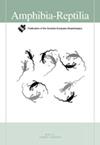Alligatorascension: climbing performance of Alligator mississippiensis
IF 1.3
4区 生物学
Q3 ZOOLOGY
引用次数: 0
Abstract
In tetrapedal locomotion, whether horizontal or during climbing, interactions between the foot and the contact surface or substrate influence the locomotor performance. Multiple previous studies of tetrapedal squamates (lizards) have reported that the animals used the same locomotor velocity, regardless of the angle of ascension. The present study was performed to determine if the American alligator (Alligator mississippiensis) would exhibit a stable climbing velocity and to determine to what degree, if any, this climbing velocity could be modified by substrate differences. Sub-adult Alligator mississippiensis, with body lengths around 170 cm, used the same stride velocity when moving at angles of 0°, 30°, and 55°. During these trials, both the sub-adult and juvenile alligators used a “low walk” gait, rather than a distinctive climbing gait. When the alligators traversed an open grate, their stride duration increased (and stride velocity decreased) presumably due to the insertion (and retraction) of their claws and digits into the grate. When climbing at 55° the juvenile and sub-adult alligators used the same stride duration; the sub-adults used a stride length that was significantly larger in absolute terms, but significantly shorter in relative terms. Despite their large size, and their more caudal center of mass, the climbing performance of Alligator mississippiensis is similar to what has been described in the previously-studied tetrapedal squamates.Alligatorascension:密西西比短吻鳄的攀爬性能
在四足运动中,无论是水平运动还是攀爬运动,足与接触面或基质之间的相互作用都会影响运动表现。以前对四足有鳞类(蜥蜴)的多项研究表明,无论上升角度如何,动物的运动速度都是相同的。本研究旨在确定美洲鳄(Alligator mississippiensis)是否会表现出稳定的爬行速度,并确定这种爬行速度在多大程度上(如果有的话)会因基质差异而改变。体长约 170 厘米的亚成体密西西比短吻鳄在 0°、30° 和 55°角移动时使用相同的步速。在这些试验中,亚成体和幼鳄都采用 "低走 "步态,而不是独特的攀爬步态。当短吻鳄穿过敞开的栅栏时,它们的步长会增加(步速会降低),这可能是由于它们的爪子和手指插入(和缩回)栅栏的缘故。当以 55° 角攀爬时,幼鳄和亚成鳄使用相同的步长;亚成鳄使用的步长绝对值明显较大,但相对值明显较短。尽管密西西比短吻鳄体型较大,尾部质量中心较高,但其攀爬性能与之前研究的四足有鳞类动物类似。
本文章由计算机程序翻译,如有差异,请以英文原文为准。
求助全文
约1分钟内获得全文
求助全文
来源期刊

Amphibia-Reptilia
生物-动物学
CiteScore
3.10
自引率
6.20%
发文量
39
审稿时长
6-12 weeks
期刊介绍:
Amphibia-Reptilia is a leading European multi-disciplinary journal devoted to most of the aspects of herpetology: ecology, behaviour, evolution, conservation, physiology, morphology, paleontology, genetics, and systematics.
Amphibia-Reptilia publishes high quality original papers, short-notes, reviews, book reviews and news of the Societas Europaea Herpetologica (SEH). The Societas Europaea Herpteologica (SEH) website is located at: www.seh-herpetology.org.
 求助内容:
求助内容: 应助结果提醒方式:
应助结果提醒方式:


